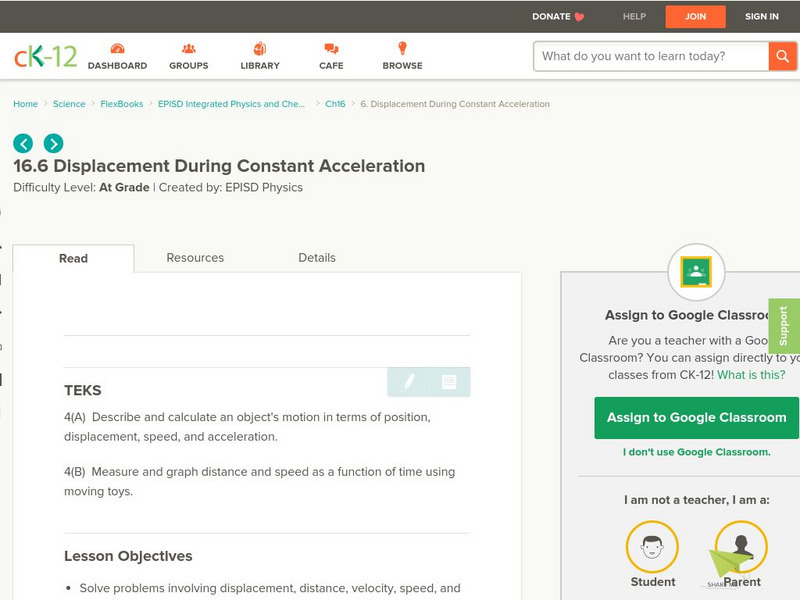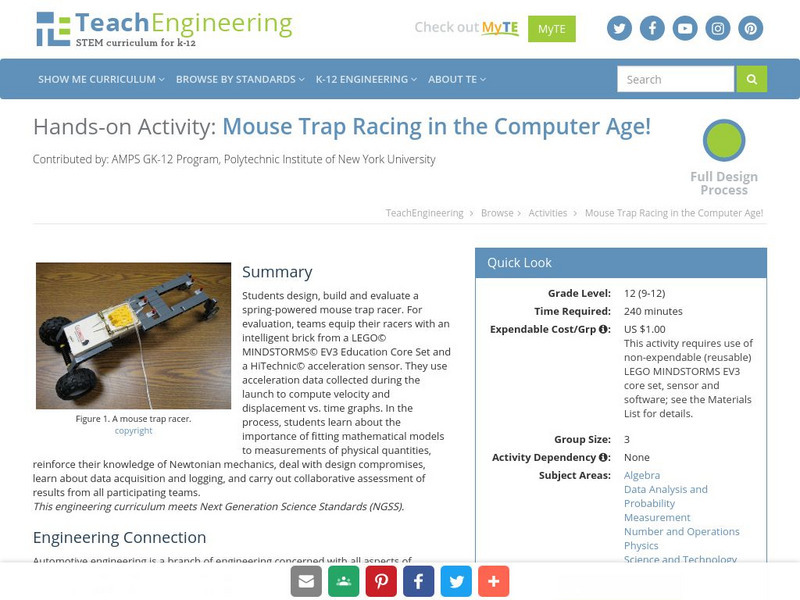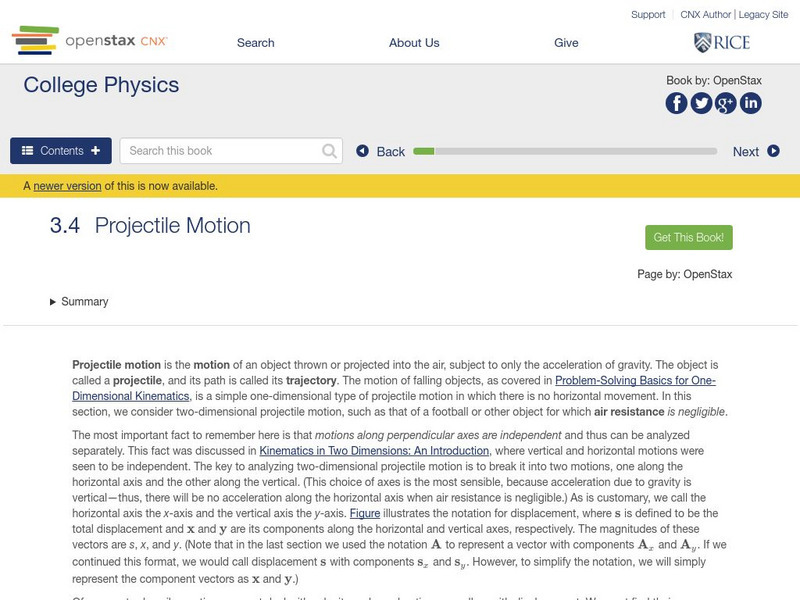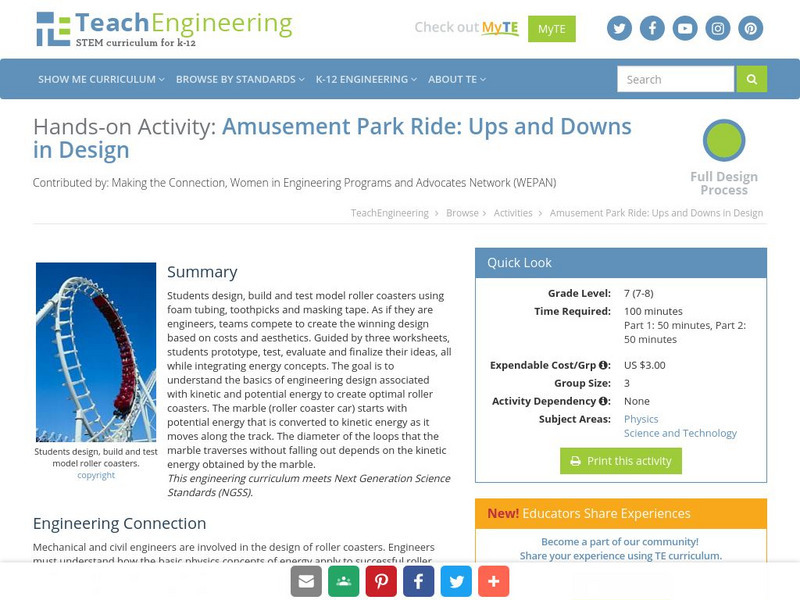Physics Classroom
The Physics Classroom: 1 D Kinematics: Distance and Displacement
Students are introduced to the two scalar and vector quantities of distance and displacement with several illustrated practice problem opportunities.
Physics Classroom
The Physics Classroom: 1 D Kinematics: Vector Diagrams
Learn how to use vector diagrams to describe the velocity of a moving object during its motion.
Physics Classroom
The Physics Classroom: 1 D Kinematics: Constant Leftward Velocity
Through an animated illustration of a dot diagram and time graphs, students learn about constant negative velocity.
Physics Classroom
The Physics Classroom: Horizontally Launched Projectile Problems
In the case of projectiles, students use information about the initial velocity and position of a projectile to predict such things as how much time the projectile is in the air and how far the projectile will go. They do this to make...
CK-12 Foundation
Ck 12: Displacement During Constant Acceleration
[Free Registration/Login may be required to access all resource tools.] Students solve problems involving displacement, distance, velocity, speed, and acceleration, and then explore problems and graphs involving one-dimensional motion.
University of California
Ucla: Speed and Velocity
Discusses the meaning of velocity in terms of a graphical representation. Calculus-based discussion. Good graphics.
TeachEngineering
Teach Engineering: Mouse Trap Racing in the Computer Age!
Students design, build and evaluate a spring-powered mouse trap racer. For evaluation, teams equip their racers with an intelligent brick from a LEGO MINDSTORMS NXT Education Base Set and a HiTechnic acceleration sensor. They use...
TeachEngineering
Teach Engineering: Projectile Motion
Students are introduced to the concept of projectile motion, of which they are often familiar from life experiences,such as playing sports such as basketball or baseball, even though they may not understand the physics involved. Students...
Other
Universidad Del Pais Vasco: Curso Interactivo De Fisica en Internet
This is a general Physics course from simple concepts such as the rectilinear movement to more complex as the energy bands of solids. Interactivity is achieved by the 646 applets embedded in web pages that are simulations of physical...
University of Minnesota
University of Minnesota: Mechanics Problems: Force and Linear Kinematics Problem
Scroll toward the bottom of this page of force and linear kinematics problems from the University of Minnesota for a series of "real life scenario" problems involving angular momentum.
Texas Education Agency
Texas Gateway: Motion Equations for Constant Acceleration in One Dimension
By the end of this section, you will be able to do the following: Calculate displacement of an object that is not accelerating, given initial position and velocity; Calculate final velocity of an accelerating object, given initial...
Texas Education Agency
Texas Gateway: Rotational Motion and Angular Momentum: Summary
This page provides a summary of each section in Chapter 10: Rotational Motion and Angular Momentum from the AP Physics online text.
Texas Education Agency
Texas Gateway: Rotational Motion and Angular Momentum: Glossary
This is the glossary of terms and definitions used in Chapter 10: Rotational Motion and Angular Momentum from the AP Physics online text.
Physics Classroom
The Physics Classroom: 1 Dimensional Kinematics
An activity in which average speed is calculated for a ball sliding along an inclined plane. This speed is compared to various instantaneous speeds along the incline.
Texas Instruments
Texas Instruments: Science Today: Clearing the Bar
In this activity, students will explore the effects of two critical physical factors on potential success in the pole vault event in track and field.
Texas Education Agency
Texas Gateway: 3.3 Vector Addition and Subtraction: Analytical Methods
By the end of this section, you will be able to understand the rules of vector addition and subtraction using analytical methods, apply analytical methods to determine vertical and horizontal component vectors, and apply analytical...
Texas Instruments
Texas Instruments: Free Fall
This activity assesses students' knowledge and understanding of free fall principles.
Texas Instruments
Texas Instruments: Picket Fence Free Fall
In this activity, students will measure the acceleration of a freely falling body (g) to better than 0.5% precision with the help of a Picket Fence and a Photogate.
Texas Instruments
Texas Instruments: Classroom Activities: Parachuting
This activity explores a parachutist and her position, velocity and acceleration. Graphing and calculating these functions will be required.
OpenStax
Open Stax: Further Applications of Newton's Laws of Motion
In the following interactive students will begin to apply problem-solving techniques to solve for quantities in more complex systems of forces. They will also integrate concepts from kinematics to solve problems using Newton's laws of...
Khan Academy
Khan Academy: Motion With Constant Acceleration Review
Review the key concepts, equations, and skills for motion with constant acceleration, including how to choose the best kinematic formula for a problem.
OpenStax
Open Stax: Displacement
In this module students will learn how to define position, displacement, distance, and distance traveled. They will explain the relationship between position and displacement and they will distinguish between displacement and distance...
OpenStax
Open Stax: Projectile Motion
The following interactive helps students understan how to identify and xplain the properties of a projectile, such as acceleration due to gravity, range, maximum height, and trajectory. They will determine the location and velocity of a...
TeachEngineering
Teach Engineering: Amusement Park Ride: Ups and Downs in Design
This unit has students design and build foam tubing roller coasters. The design process integrates energy concepts as they test and evaluate their designs that address the task as an engineer would. The goal is for students to understand...



















